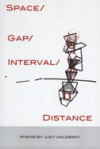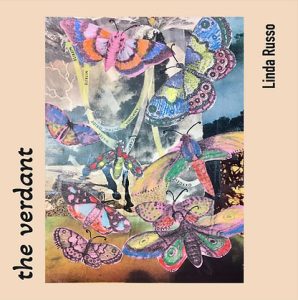Space / Gap / Interval / Distance
In Space / Gap / Interval / Distance, Judy Halebsky draws the many strands of her life’s arts together, braiding the leaps and bounds of expression into a fantastic set of ekphrastic poems.
In Space / Gap / Interval / Distance, Judy Halebsky draws the many strands of her life’s arts together, braiding the leaps and bounds of expression into a fantastic set of ekphrastic poems.
As Halebsky explains in her notes, the book comes out of the experiences of crossing into literal and figurative regions of other languages, beginning with her early life in Eastern Canada: “I walked each morning through a gate into a French-speaking world . . . at 3:15 I crossed back into the English-speaking world of the bus and my neighborhood. Years later, when I came to study Japanese as an adult, I carried with me that experience of moving between languages and trying to piece them together.”
Many of the poems dwell on the way new languages twist and open new realms of thought, especially as Halebsky examines the strokes and meanings of Japanese alphabet. “Rad. 22,” which borrows its style from a numbered dictionary of Japanese characters called radicals, is the first poem I’ve ever read that adequately describes the power and emotion shared in the human eye:
Amigashira: crown. Variant: net shaped like eye.
I ask Joey how far the human eye can see
he wants to say forever
but he says, you can see stars, right?
I know then that he will never leave me
The poems are further influenced by the teachings of the late Kazuo Ohno, who co-created butoh dance, “a dance form that rejects established dance traditions and searches for untrained movements of the body.” I have a hunch that Halebsky is rarely content with the usual clichés of expression, and so spends her energy diving into all forms of art and communication, to find some thing, or an amalgam of things, to satisfy the need for “untrained movements.”
“Out of the Gate” lists such experiences—“I have breathed into a thousand balloons // put my fingers in so many cakes”—and demonstrates how Halebsky eschews the usual constructions and expectations of the English language. It ends: “there’s a snail who thinks he’s climbing Mount Fuji // the racetrack is filled with stars.” (An essay for another time should examine the presence of cakes and other baked goods in Halebsky’s work.)
Space / Gap / Interval / Distance reads as if the person who wrote it is quite comfortable in her command of language; I wouldn’t be surprised to find Judy Halebsky at her notebook, continuing to twist the unexpected out of her words.





